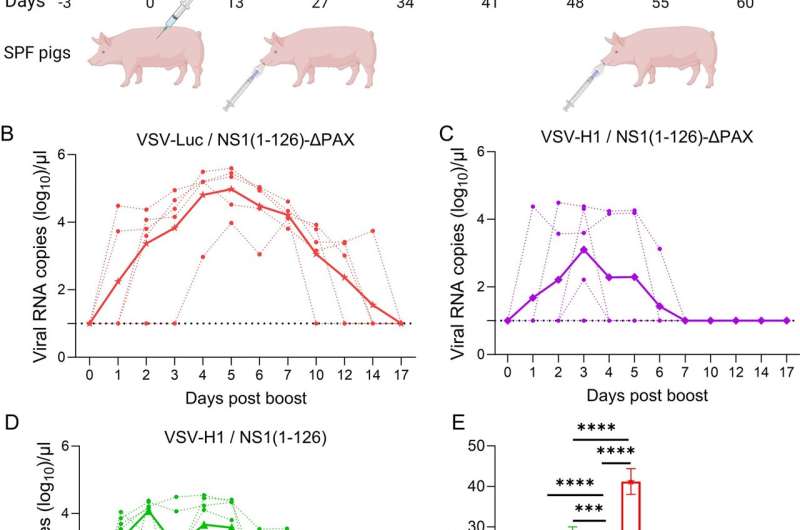This article has been reviewed according to Science X's editorial process and policies. Editors have highlighted the following attributes while ensuring the content's credibility:
fact-checked
peer-reviewed publication
trusted source
proofread
Intramuscular prime/intranasal boost vaccine strategy shows promise in porcine flu model

A new, two-step flu vaccination strategy that pairs intramuscular injection of a viral vectored flu vaccine with nasal spray administration of a novel attenuated live flu virus appears to be safe and effective in pigs. Robin Avanthay of the Institute of Virology and Immunology in Mittelhäusern, Switzerland, and colleagues present these findings in the open-access journal PLOS Pathogens.
Seasonal flu vaccines typically consist of inactivated components of flu virus injected into muscle, helping the body's immune system to recognize and fight the disease. However, this approach has limited ability to prevent infection where it initially occurs in the upper respiratory tract, and it can foster evolution of new versions of flu capable of evading immune attack.
An effective alternative is a live-attenuated vaccine, which uses a modified flu virus that has been weakened so it cannot cause disease. Live-attenuated influenza vaccines can be administered through the nose directly into the upper respiratory tract, where it prompts a multi-pronged immune response against infection.
The authors' novel live-attenuated vaccine candidate induced a strong local immune response that protected pigs against the flu virus. However, although the vaccine did not cause any symptoms in pigs, it was shed from the upper respiratory tract for a prolonged time.
If such a vaccine were used in humans, there is a chance that it could be transmitted to someone with a compromised immune system, potentially causing health problems.
Aiming to strike a balance between advantages and risks, Avanthay and colleagues developed a two-step immunization strategy.
Prior to the nasal administration of the live-attenuated flu vaccine candidate called NS1(1-126)-ΔPAX, the animals were primed with a vesicular stomatitis virus (VSV) as a vaccine delivery mechanism.
VSV represents a promising vector approach across vaccine research. However, in contrast to commonly used VSV-vectored vaccines, the vaccine used in this study was "propagation-defective"—engineered to perform only a single round of infection for safety.
When tested in pigs, this strategy resulted in a strong immune response, both body-wide and specifically in the upper respiratory tract where initial flu infection occurs.
No infection was detected in the two-step-vaccinated pigs after they were exposed to a virulent flu virus. Thus, as the novel immunization approach efficiently blocks flu virus replication in the upper respiratory tract, it may prevent shedding and transmission of flu virus during seasonal epidemics.
When compared to pigs that only received NS1(1-126)-ΔPAX on its own, the two-step-vaccinated pigs showed significantly less shedding of the vaccine candidate from their upper respiratory tract.
Importantly, the intranasally administered live vaccine boosted the systemic flu-specific antibody response and resulted in higher frequencies of flu-specific T helper memory cells, which was the case if the live vaccine was used without prior priming. Thus, this novel two-step vaccination strategy may foster the duration of protective immunity as well as the protection against flu virus variants.
The researchers conclude that this novel two-step approach holds promise as a next-generation strategy for fighting flu more effectively, though further testing is needed before this vaccine approach can be used in humans.
Co-author Dr. Gert Zimmer summarizes, "A novel prime/boost vaccination strategy against influenza was evaluated in the porcine animal model.
"We combined the primary intramuscular immunization with a propagation-defective replicon vaccine with the secondary intranasal immunization using a genetically modified live-attenuated influenza vaccine (LAIV), and found that this immunization regimen resulted in reduced LAIV shedding, increased production of specific serum IgG, neutralizing antibodies, Th1 memory cells, and fully protected the animals against homologous virus challenge."
More information: Evaluation of a novel intramuscular prime/intranasal boost vaccination strategy against influenza in the pig model, PLoS Pathogens (2024). DOI: 10.1371/journal.ppat.1012393




















